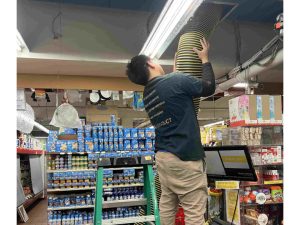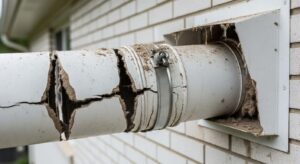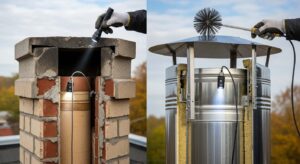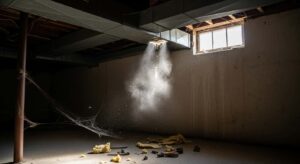Have you noticed your home getting dusty too fast or odd smells when the HVAC kicks on? It might be time to take a closer look at your air ducts. While often overlooked, dirty ductwork can silently affect your indoor air quality, energy bills, and even your health. And if you’re like most homeowners, you’re probably wondering where to start and which cleaning method is worth it.
If you’ve recently completed a remodel or construction project, scheduling a renovation air duct cleaning is crucial to eliminate drywall dust, sawdust, and other contaminants that get trapped in your system.
In this blog, we’ll explore the different air duct cleaning methods and the key factors to consider when selecting the best option for your home.

Air Duct Cleaning Methods
Air duct cleaning is crucial for maintaining the efficiency of your HVAC system and ensuring good indoor air quality. There are several methods available for cleaning air ducts, each suited to different contamination levels, duct types, and cleaning needs.
Below are the primary methods used in commercial and residential air duct cleaning, along with key factors to consider for each.
1. Source Removal Cleaning
Source removal cleaning is a common and effective method used for cleaning air ducts. It involves physically dislodging debris, dust, and contaminants from inside the ducts using specialized equipment such as brushes, air whips, and vacuum systems. Once the debris is loosened, it is immediately vacuumed away to ensure it doesn’t recirculate in the home.
Effectiveness:
Source removal cleaning is highly effective for removing light to moderate dust and dirt buildup. It works well when the ducts are relatively clean, but it may not be sufficient for severe issues like mold or thick debris. The method ensures that contaminants are physically removed, leaving the ducts cleaner.
Safety:
This method is generally safe for most types of duct materials, including rigid metal ducts. However, it is important to ensure that the cleaning process doesn’t damage fragile duct materials, especially in older systems. Careful handling of equipment is necessary to avoid accidents.
Suitability:
Best for homes with mild to moderate dust accumulation, like those with pets or high foot traffic. It’s not ideal for removing mold, bacteria, or deep contaminants, which may require more specialized methods.
System Compatibility:
Source removal cleaning is compatible with most HVAC systems, especially rigid ducts. Flexible ducts may be at risk of damage from the brushing or vacuuming process, so care should be taken with their cleaning.
Cost:
This method is cost-effective compared to more advanced methods like chemical treatments or truck-mounted vacuum systems. It’s an affordable option for routine maintenance, especially in homes that don’t require heavy-duty cleaning.
Longevity:
While source removal cleaning is effective for removing everyday dust, it may not last long if mold or significant buildup is present. Regular cleaning is necessary to maintain optimal air quality, particularly in high-dust environments.
2. Negative Pressure Vacuuming
Negative pressure vacuuming, or truck-mounted vacuuming, uses a large vacuum system connected to a truck. The vacuum creates powerful suction to pull debris from the ducts, drawing contaminants into the truck’s filtration system. This method is highly effective for deep cleaning and for homes with significant contamination levels.
Effectiveness:
Truck-mounted vacuuming is extremely effective at removing large volumes of dust, debris, mold, and other contaminants. The powerful suction ensures that even the most stubborn particles are removed from the system, improving air quality significantly. This method is especially useful for homes with heavy contamination or those located in dust-prone areas.
Safety:
While truck-mounted systems are safe for rigid ducts, the high suction pressure can damage flexible ducts. If your system includes flexible ducts, this method may not be the best option unless handled with care. Always ensure that the equipment used is appropriate for the ductwork in your home.
Suitability:
Ideal for homes with heavy dust accumulation, mold growth, pet dander, or other significant contaminants. It is also recommended for homes with large HVAC systems that require powerful cleaning solutions.
System Compatibility:
This method is well-suited for rigid metal duct systems but may not be suitable for flexible ducts unless the technician is highly skilled and takes special care. Always discuss your duct type with the cleaning service beforehand.
Cost:
This method tends to be more expensive because of the equipment required and the labor involved. However, it provides thorough cleaning and long-term benefits, making it worth the investment for homes with severe contamination.
Longevity:
Truck-mounted vacuuming offers long-lasting results, especially for homes with mold, bacteria, or thick debris buildup. Regular maintenance will be needed, but the cleaning results last longer compared to simpler methods.
3. Rotary Brush Cleaning
Rotary brush cleaning involves a rotating brush that is inserted into the ducts to agitate and dislodge dirt and debris. Once the debris is loosened, it is vacuumed out through a high-powered suction system. This method is effective for cleaning light to moderate dust and dirt buildup from inside the ducts.
Effectiveness:
Rotary brush cleaning is effective for removing moderate dust and dirt from ducts. However, it may struggle with more stubborn contaminants such as mold, grease, or heavy buildup. It’s ideal for routine maintenance and light cleaning jobs.
Safety:
This method is generally safe for most ducts, but caution is needed when cleaning older or fragile ducts. The mechanical agitation of the brush can damage flexible ducts if they are not handled properly. Always ensure that the technician uses the correct equipment for your duct system.
Suitability:
Best suited for homes with light to moderate dust accumulation. It’s not the best choice for severe mold or deeply embedded contaminants, where more specialized cleaning methods are required.
System Compatibility:
Works well with rigid metal ducts but can be problematic for flexible ducts. The rotating brush can be too aggressive for softer materials, potentially causing tears or damage.
Cost:
Affordable and commonly used for routine duct maintenance. This method is typically less expensive than truck-mounted vacuuming or chemical treatments, making it a good option for those needing light cleaning.
Longevity:
The cleaning effect is generally short-term, as dust can accumulate quickly in environments with high foot traffic or pets. Regular cleanings are recommended for maintaining air quality.
Also Read: The Hidden Health Hazards of Dirty Air Ducts
4.Air Whip Cleaning
Air whip cleaning uses a powerful burst of compressed air to dislodge debris from the ducts. The dislodged material is then vacuumed out using a high-powered vacuum system. This method is efficient for loosening dust and debris from inside the ducts and is often used in conjunction with other cleaning techniques.
Air whip cleaning is effective for light to moderate contamination, but it’s best to begin with a professional air duct inspection or indoor air quality test to determine the right cleaning method for your system.
Effectiveness:
Air whip cleaning is effective for light to moderate contamination, especially in ducts with dust and loose debris. However, it may not be as effective at removing heavier debris, mold, or deeply embedded particles, which require more intensive cleaning methods.
Safety:
This method is safe for most duct materials but should be used cautiously with fragile or older ducts. High-pressure air can cause damage if not applied carefully, particularly in delicate or older HVAC systems.
Suitability:
Great for occasional dust cleaning and homes with moderate dust accumulation. It may not suffice for more severe contamination, like mold or grease buildup.
System Compatibility:
Works well with both flexible and rigid ducts. The flexible nature of the air whip makes it versatile, but it should still be used cautiously to prevent damage.
Cost:
Air whip cleaning is relatively affordable and typically used for routine cleanings. It’s less expensive than truck-mounted systems and is often used for less severe contamination.
Longevity:
Similar to rotary brush cleaning, air whip cleaning provides short-term results and requires regular maintenance, especially in homes with high dust levels.
5. Chemical Biocide Treatment
Chemical biocide treatment involves applying specialized chemicals to kill bacteria, mold, and other microorganisms inside the ducts. The biocides target harmful contaminants, ensuring that they are neutralized and preventing future growth.
Chemical biocides are highly effective in treating microbial contamination, especially mold and bacteria, making them a key component of thorough disinfecting air duct services or targeted antimicrobial treatments.
Effectiveness:
Chemical biocides are highly effective in treating microbial contamination, especially mold and bacteria. However, this method is often used in conjunction with physical cleaning methods to ensure the ducts are thoroughly cleaned before treatment.
Safety:
While chemical biocides are generally safe, improper application can leave harmful residues in the ducts. It is crucial to use the appropriate products and apply them correctly to avoid negative health effects.
Suitability:
Best for homes with mold, mildew, or bacterial contamination. It is not suitable for dust or dirt removal and should always follow a physical cleaning process.
System Compatibility:
Chemical treatments are compatible with most HVAC systems, but care should be taken to avoid contact with system components like coils and filters that may be damaged by chemicals.
Cost:
Chemical biocide treatment tends to be more expensive due to the cost of chemicals and professional application. However, it provides long-term benefits, especially for homes with significant microbial contamination.
Longevity:
The effects of chemical biocide treatments last longer than simple cleaning methods, but they may need to be reapplied depending on environmental conditions, such as humidity.
6. Ultraviolet Light Cleaning
UV light cleaning uses ultraviolet light to sterilize the inside of ducts, preventing microbial growth and improving air quality. It is particularly effective in preventing mold and bacteria from returning after physical cleaning.
UV light cleaning is highly effective for preventing microbial growth, particularly mold and bacteria, making it a valuable addition to any UV light installation.
Effectiveness:
UV light cleaning is highly effective for preventing microbial growth, particularly mold and bacteria. However, it does not physically clean the ducts or remove dust and dirt, so it’s best used alongside physical cleaning methods.
Safety:
UV light is safe for most duct materials, but prolonged exposure can degrade plastic components over time. It is important to install the UV light system correctly to avoid damage to the HVAC system.
Suitability:
Ideal for homes with persistent microbial issues, particularly those in humid environments. It is best used as a preventive measure rather than a standalone cleaning solution.
System Compatibility:
Compatible with most HVAC systems. UV light systems are installed near the air handler or coil and work effectively to sterilize air as it passes through the ducts.
Cost:
UV light systems can be expensive to install initially, but they provide long-term benefits by preventing microbial growth, making them a good investment for homes with ongoing air quality concerns.
Longevity:
UV light systems are highly effective for long-term microbial control, provided they are maintained and the bulbs are replaced as needed.
Also Read: How To Find a Good Air Duct Cleaning Company in NJ?
How to Choose the Best Air Duct Cleaning Method
Choosing the best air duct cleaning method depends on several factors specific to your home, HVAC system, and the level of contamination within your ducts. Understanding these factors can help you select the most effective and efficient cleaning solution for your needs.

Below, we discuss the key considerations that should guide your decision.
1. Level of Contamination
If your ducts are lightly contaminated, simpler methods like source removal cleaning or rotary brush cleaning will do the job. These methods are effective at removing dust, dirt, and debris, making them ideal for regular maintenance.
However, if your ducts are heavily contaminated with mold, pet dander, or thick dirt buildup, you’ll need more powerful methods like truck-mounted vacuuming or chemical biocide treatment. These methods are designed to remove deeper contamination and prevent future problems like mold growth.
2. Type of Ductwork
The material of your ductwork plays a major role in deciding the cleaning method. Rigid ducts, made of metal, can withstand aggressive cleaning techniques such as truck-mounted vacuuming and source removal cleaning. These methods use powerful suction and tools to clean thoroughly.
For flexible ducts, which are more delicate, gentler methods like rotary brush cleaning and air whip cleaning should be used. These methods dislodge dirt and debris without risking damage to the ducts, ensuring an effective clean without compromising the system.
3. Budget and Cost Considerations
Cost is an essential factor when selecting a cleaning method. Source removal cleaning and rotary brush cleaning are generally more affordable, making them great options for regular cleaning without significant investment.
If your budget allows for a more thorough clean, methods like truck-mounted vacuuming and chemical biocide treatment are more expensive but offer deeper cleaning and longer-lasting results. Consider what fits best within your budget and whether long-term benefits justify the higher upfront cost.
4. Frequency of Cleaning
If you plan to clean your ducts every couple of years, source removal cleaning or rotary brush cleaning may be enough. These methods work well for regular maintenance and prevent dust and debris from building up.
For homes in areas with heavy pollution, high humidity, or frequent mold problems, you may need more frequent cleaning. In such cases, truck-mounted vacuuming or UV light cleaning can help by removing contaminants and preventing future buildup. These methods are more effective for homes requiring constant upkeep.
5. Health and Environmental Concerns
For homes with residents suffering from allergies, asthma, or respiratory issues, health and environmental considerations are crucial. Chemical biocide treatment is great for eliminating mold, bacteria, and fungi from the ducts, improving air quality. However, some people prefer chemical-free options due to sensitivities.
In these cases, truck-mounted vacuuming, air whip cleaning, and UV light cleaning are excellent alternatives. These methods don’t use chemicals but still provide thorough cleaning, ensuring clean and healthy air without introducing harmful substances.
6. Desired Long-Term Results
If you’re looking for long-term results, methods like chemical biocide treatment and UV light cleaning are ideal. These options not only clean the ducts but also kill harmful microorganisms like mold and bacteria, providing lasting protection.
On the other hand, methods like source removal cleaning or rotary brush cleaning provide short-term results and may require more frequent cleanings to maintain optimal air quality. If long-term protection is your goal, investing in these methods will save time and effort in the future.

Also Read: Why Air Ducts Smell and How to Fix It
Need Help With Air Duct Cleaning?
If your air ducts are clogged or contaminated, trying to clean them yourself might not give you the results you need. At Alpha Clean Air, our experienced team specializes in professional air duct cleaning services, ensuring your ducts are free from dust, allergens, and other harmful particles. Whether you need a simple maintenance clean or a deep clean for serious contamination, we’ve got you covered.
Breathe easier and improve your indoor air quality with our expert services—contact us today to schedule your air duct cleaning!





